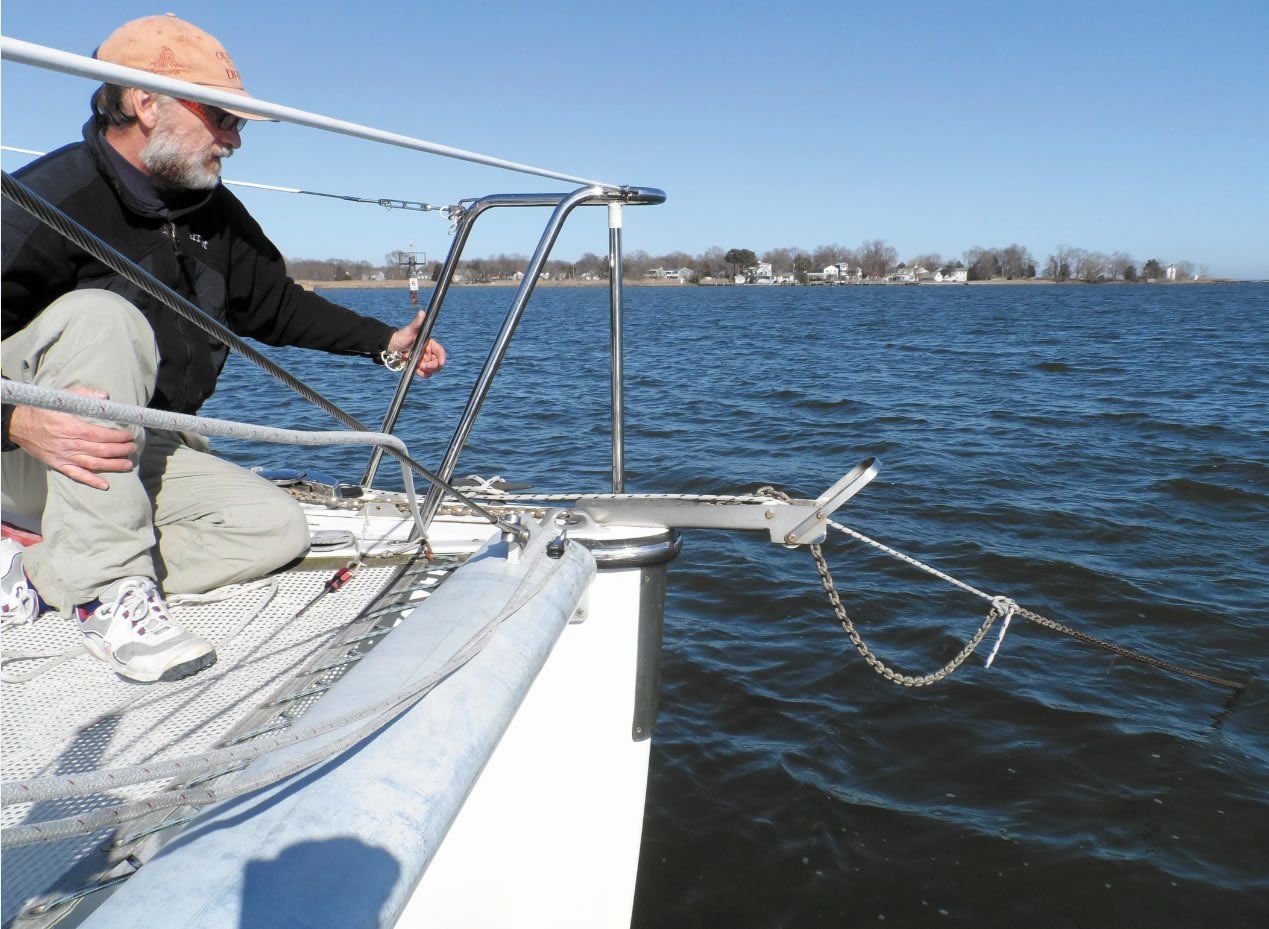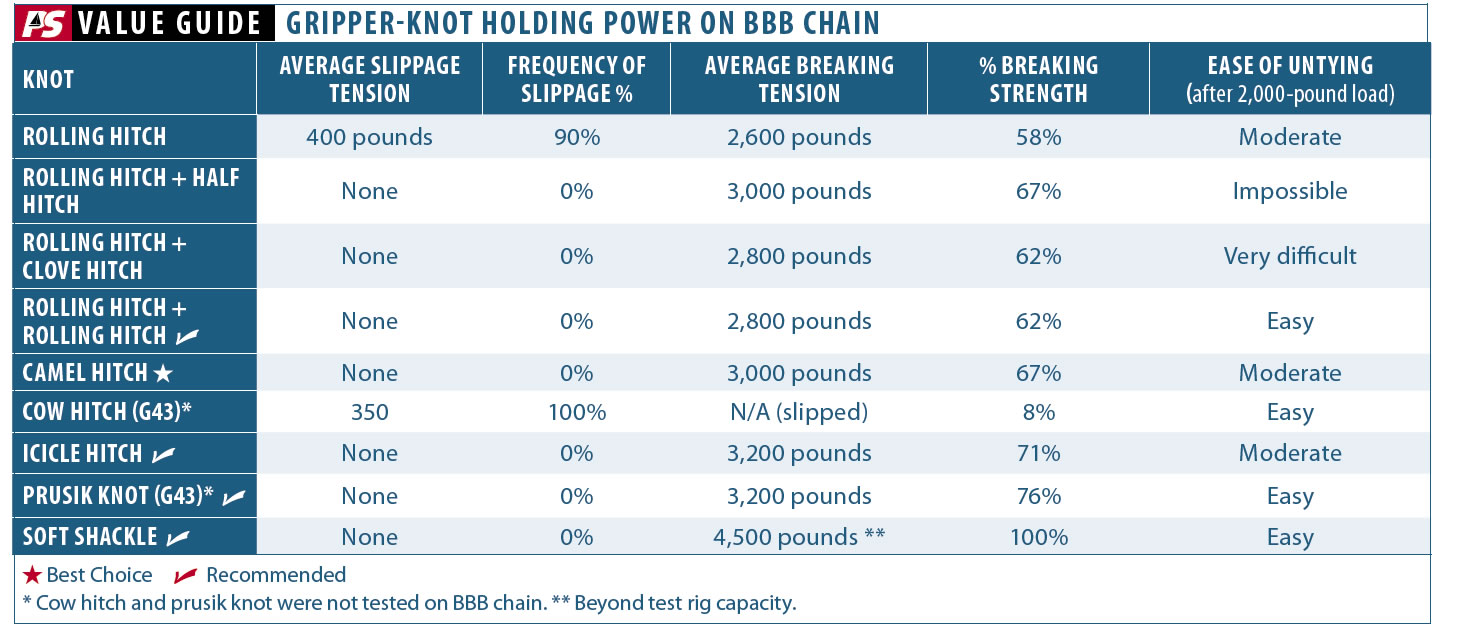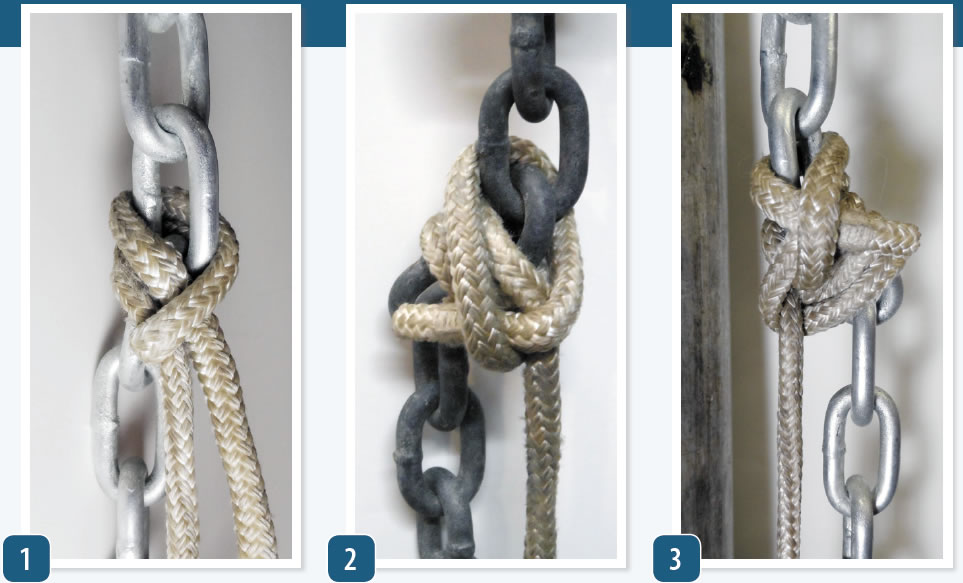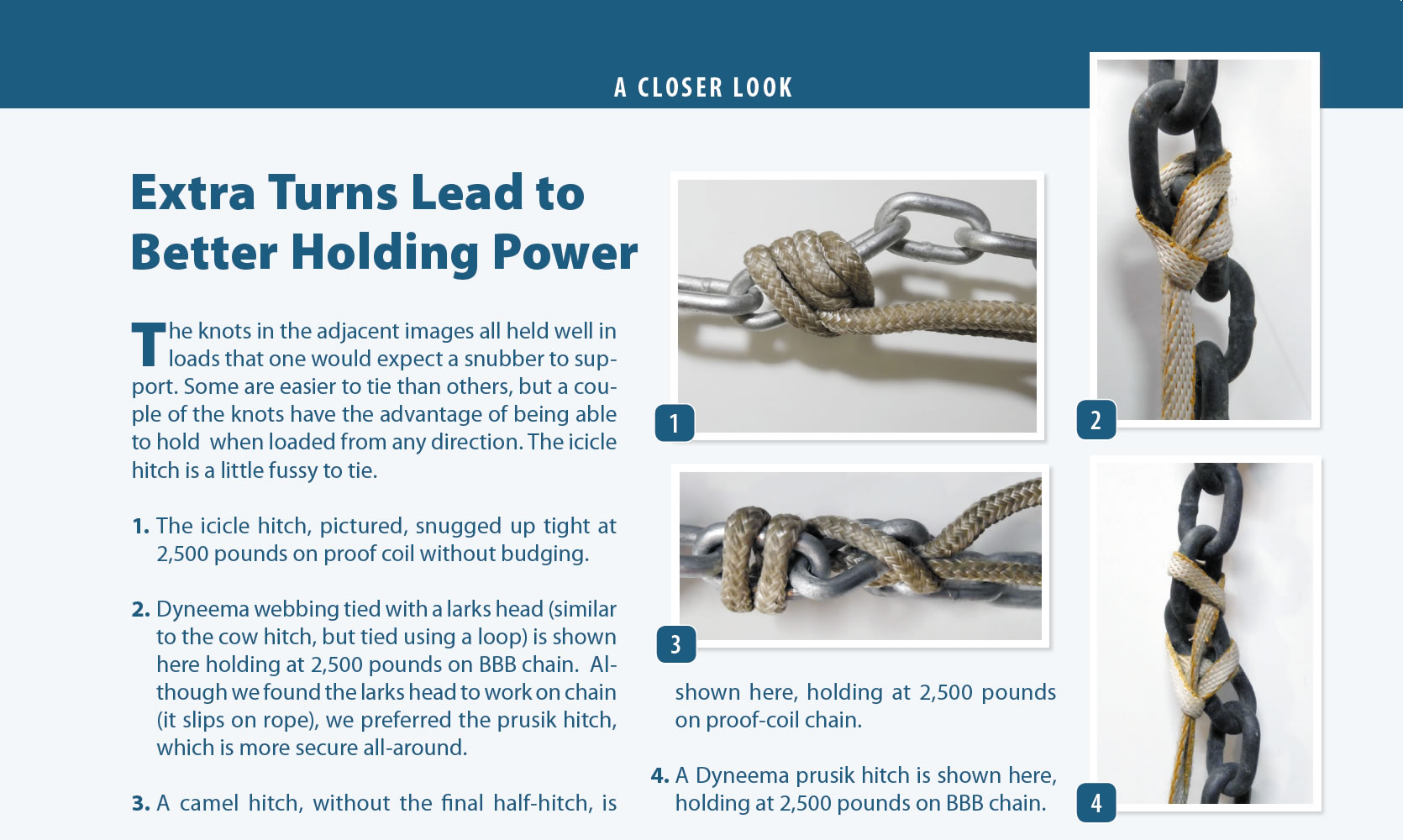When researching Changing Views on Chain Hooks (see PS, March 2016 online), we were surprised to discover that some chain hooks greatly reduced the breaking strength of a chain. Unless the hook itself broke, we assumed its effect on chain strength would be very minor.
Our instinctive response to this discovery was to revert to tradition-just throw a hitch around the chain and be done with it. A knot costs nothing, and theres no chance of harming the chain.

But weve learned that knots and splices can be tricky things, not always behaving as expected. So, before putting all our chips on the rolling-hitch alternative to using a chain hook, we decided to do some testing.
How well will various hitches really hold on to chain? We had an inkling of how things would turn out based on previous tests. As long-time cruiser Joe Minick pointed out in PSs May 2007 article, a rolling hitch does not hold chain nearly as well as a camel hitch. And, in the 2009 article Gripping Hitches for Loaded Lines, circumnavigator Evans Starzingers carried out a comprehensive test of various knots (see PS, August 2009 online). Although Starzingers test involved tying a variety of hitches to other lines and stainless tubing (stanchions), it seemed reasonable to assume that these results would also apply to chain.
Indeed, this current round of testing showed that the rolling hitch was not the most reliable knot, just as Starzinger had found. Three times in a row, the knot began slipping long before loads had reached the knotted lines expected failure point. (Most knots reduce a lines strength, sometimes significantly.)
In some instances, the knot failed at loads lower than those of our previous tests. Based on our observations, it appeared that the reason for the slipping was that the chain moves differently than a line or tubing. The links slide and kink, causing the knot to change shape and even come undone. A rolling hitch was most definitely not the best knot. As Starzinger also demonstrated, there are better, although more complex, knots for gripping. But would these more complex knots be any better with chain?
The only way to find out was to break some lines and put some real numbers on paper.
What We Tested
Based on our research, we narrowed the field to eight knots: the rolling hitch, twin rolling hitches (one behind the other), a rolling hitch with a backup hitch, a camel hitch, an icicle hitch, a cow hitch, a prussic hitch, and a soft shackle (formed separately on smaller-diameter Dyneema line).
How We Tested
Using the same test rig we used for breaking sewn splices (see PS, October 2014), we tied each of the knots around lengths of chain and pulled until they either slipped continuously or broke. All knots were tied with 3/8-inch nylon double braid, and we tested with quarter-inch, galvanized proof coil, BBB (Grade 30), and high tensile chain (G43, also known as G4) . We tested each knot/chain combination twice, unless we observed slipping, in which case we repeated the testing up to 10 times, to determine the frequency of slippage.

In addition to holding strength, we were interested in other factors. Were some knots more forgiving than others? You don’t always have perfect access when attaching a snubber to a chain. And the chains uneven surface precludes perfectly dressed bumps.
We also wanted a knot that would untie easily. Weighing anchor is a busy time. In a crowded anchorage, or on a lee shore, we can’t be fooling around with a marlinspike while the anchor and chain is banging around. To test ease of untying, once a knot held to 2,000 pounds, we released the tension and tried to untie it. Some were easy, and some required a knife.

Observations
Normally, we expect gripper hitches to fail by sliding, but that is not the case on chain. The links offer too much purchase against length-wise slippage. No gripper hitch slid down the chain nor suggested it ever might. However, chain behaves strangely underneath the knots, the result being that it is practically impossible to tie a knot in the same way twice. Each time a knot draws up tight, the strands slide along the links, pushing the links this way and that, seeking a stable arrangement, and each time the resulting knot is a little different from the last. Knots that held to breaking never looked quite the same twice, resulting in variable breaking strengths. The result was some inconsistent data, but a few things were quite clear.
First of all, the specific chain makes only a minor difference. Proof coil seemed to hold best, BBB held worst, and G43 was somewhere in the middle. Each type of chain had a slightly different texture, so this may have influenced results more than the size and shape of the links. However, the hitches that failed to hold slipped on every chain type, and those that held did so on every chain type. Because we saw little variation between chain types, we are publishing only the table for BBB chain, a common anchor chain in the U.S.
The specific line type, size, and construction can affect knot strength. We tested three-strand nylon a few times and found minor differences according to lay (hard versus soft), diameter (3/8-inch and half-inch), and age, but we found no discernible patterns. We tested old half-inch, nylon double braid and old half-inch, polyester double braid; the results were the same as for 3/8-inch, nylon double braid. Thus, although we have reported data only for 3/8-inch, nylon double braid, we feel confident that other rope types and sizes would follow the same general pattern of failure.
One interesting observation regarding rope material was how the diameter of nylon rope shrunk as the rope was stretched, and then expanded when the load was released. This made the nylon generally more difficult to untie. The diameter of the polyester line was more stable under load, so polyester was consistently a little easier to untie.
Although nylons greater elasticity makes it better for shock absorption, one might consider adding a short stretch of polyester where the snubber ties to the chain. In fact, one of our testers has been using a six-foot polyester leader at the apex of the bridle snubber he uses to anchor a catamaran. He has found nylon to be more durable, stronger when wet, and better at holding knots.
As mentioned, the rolling hitch nearly always slipped at high load-in over 20 tries, it held more than 500 pounds of load only once. Although this will be news to some sailors, our research found that more experienced cruisers no longer use a simple rolling hitch. The sailors we spoke with had switched to either twin rolling hitches (one tied above the other), a camel hitch, or an icicle hitch.
We quickly learned the advantage of twin rolling hitches. The knots are easy to untie after a high load. By comparison, a rolling hitch combined with some other backup knot-either half-hitches or a clove hitch securing the tail to the loaded part of the chain to lessen the slippage of the tail into the rolling hitch-usually jammed so badly that we had to untie them with a knife or marlinspike.
Most gripper hitches are not appropriate for joining rodes together for Bahamian moors, a two-anchor mooring system in which the boat is held between two anchors set in line, so that the boat is kept in approximately the same place-holding alternately on one anchor and then the other-as the current or wind reverses. Most gripper hitches are simply not designed to take the load at 90 degrees to the chain or in more than one direction of pull (as can occur with a Bahamian moor). In this case, it would be better to use either a prusik knot or a soft shackle through a link. Some have suggested that a locking chain hook might be used to attach the second anchor to the chain in a tandem anchoring arrangement, but we have not tested this setup enough to recommend the practice.
Although the testing weve done so far is fairly preliminary, we feel confident enough that the following results for each knot can serve as a good guide for what to expect when tying to anchor chain. There are several websites and books that describe tying the knots. The encyclopedic Ashley Book of Knots is our definitive resource for knots. The Animated Knots website (www.animatedknots.com), which has videos demonstrating how to tie most common knots, is one of the most popular and useful online resources.
Rolling Hitch
The conventional wisdom is that a rolling hitch is simplicity itself, and yet over and over again in tests, the knot would start to unwind at a paltry 10 percent of its breaking strength. The problem with this knot is made worse by its stealthy nature. The rolling hitch will hold just fine when the anchor sets and the boat is exposed to normal loads, but once storm-force loads set in, it begins to slip.
Based on previous results published in What is the Ideal Snubber Size (see PS, March 2016 online), our test boat, a 34-foot catamaran could experience more than 1,000 pounds of load in a storm packing 60-knot winds. As mentioned, only once did the rolling hitch hold 500 pounds (on proof coil), and it slipped at very near 500 pounds in every other trial, on every chain type and with every rope type and size. Keep in mind that on this boat, only 270 pounds of reverse thrust are available to set the anchor, so one could easily presume that all was well and that the knot wouldnt be a problem as winds picked up.
When the knot did lock down, it held to 60-percent of its breaking strength, which is respectable for a knot. So how is it that many sailors report 100-percent success for years, and why are there relatively few reports of failures? With a proper snubber, the critical load is not reached until the wind reaches 45 knots. Unless you are cruising in extremely stormy regions, being fully exposed to storm-force winds at anchor is a rare occurrence. Sure, storm winds may be recorded at the masthead or by meteorological sensors, but deck-level wind speeds will likely be much less. Even those who have encountered such winds may not have noticed the knot slipping, since this happens gradually. The point is this: Even a full-time cruiser could go for years before experiencing a rolling hitch slip.
Bottom line: The only advantage this knot has over others is that it can be tied (with practice) with one hand. Not recommended for use as a chain snubber.
Rolling Hitch with backup knot
In our research, we came across several suggestions that the rolling hitch could be made more secure by leaving a long tail and tying either a string of half-hitches or a clove hitch around the loaded portion of the chain. We tried both of these, and this stopped the slipping. However, when put under load, the hitches jammed against the rolling hitch and the resulting knot was generally very difficult to release. In some instances, we resorted to using a knife.
Bottom line: Although this knot is easy to tie and provides additional security to a rolling hitch, there are better combinations.
Cow hitch
This simple knot is sometimes seen being used by novice sailors to attach a snubber. In tests, it slipped at about 300 to 400 pounds every time.
Bottom line: This knot is best left on the farm.
Twin rolling hitches
A couple of cruisers we communicated with said they simply tie twin rolling hitches, one above the other, to grip chain. This combination never slipped in our test. You need to leave a long tail after the first knot, which makes tying more difficult than some of the other knots in our test, but with practice, it can still be tied with just one hand. It takes longer to tie than the other knots we tried, except for the icicle hitch. However, it performed flawlessly and was never difficult to untie.
Bottom line: If youre comfortable with a few extra turns around the chain, two rolling hitches are an excellent option for connecting a snubber to chain.
Camel hitch
This knot is identical to a rolling hitch in the line-gripping part, but the last turn is reversed and there is half-hitch securing the tail. In our tests, it gripped every time. It is easy to remember how to tie and dependable. For added security, we recommend leaving a long tail and securing it to the chain with a second half-hitch, if you are going to stay a few days. This knot is pretty tricky to tie with one hand, but it is not difficult to release after it has been put under high loads.
Bottom line: A good combination of simplicity and holding power, the camel hitch is our Best Choice for simply tying rope to chain.
Icicle Hitch
The strongest of the rope-end hitches tested, the icicle hitch never slipped and weakened the rope less than the others. However, it is very tricky to tie with one hand. It is not difficult to release.
Bottom line: This is a secure knot. We recommend the icicle hitch for those who want to keep their knot-tying skills sharp and don’t mind making extra effort for security.
Prusik hitch
We used this knot with a climbing sling made of Dyneema. A climbing sling is a loop of webbing stitched to form a circle. (An example is the Contact 8-millimeter Dyneema Climbing Sling made by Mamut.) One of our testers, Drew Frye, who is also a mountain climber, used this method for years before switching to improved chain hooks and soft shackles.
The prusik hitch is a very simple knot, perhaps the easiest of the group. It can be secured in bouncy conditions, either inside or outside the roller, and will slide easily over an anchor roller upon retrieval without being harmed. To attach it to the chain, you simply loop the sling around the chain and through itself like a luggage tag, making two passes around the chain and through the loop. The loop is then attached to a spliced eye on the end of the snubber using a bow-shackle or soft shackle. You can also use a load-tested climbing carabiner to make this connection, although these are not made of marine-grade metals and are not recommended for marine use.
This arrangement is fast and idiot-proof in the worst conditions, and it can be removed in a few seconds. Dyneema webbing (8 millimeter) is suitable for boats up to about 45 feet; for larger boats, splice a stronger, closed loop using Dyneema rope.
Perhaps the greatest advantage of the prusik hitch is that it is unidirectional; it does not matter which direction the pull is. This can be important when two rodes are joined in a Bahamian moor and the pull on the chain can come from a wide range of angles, including slightly up the chain. Most other gripper hitches will fail in this orientation.
Bottom line: A reliable connection, the prusik hitch is recommended for those who want a quick, easy knot that is secure in any angle of pull.
Soft Shackle
Made from high-strength Dyneema fibers, soft shackles are easily as strong as the chain they attach to. Some sailors find them tricky to attach-they are threaded through a link rather than fastened around the chain-but if you buy or make slightly oversized shackles designed for this sort of application instead of the smaller sizes that some chandleries sell as replacements for D-shackles, they arent so difficult to manipulate.
In the April 2015 issue, we described how to make your own shackles. Standard soft shackles can be tricky to open and close after they have accumulated a little scale and junk, whereas more open designs remain limber. They are easy to attach inside the roller. Like the prusik hitch, a soft shackle is omnidirectional.
Bottom line: A soft shackle is easy to attach and untie, and offers excellent strength, but you must be willing to learn to tie your own. For directions on making your own, search for the Edwards soft shackle on www.animatedknots.com.
Conclusions
The clear loser in this test was the rolling hitch. It slipped at about 500 pounds with every line type and diameter. While the rolling hitch has served many cruisers faithfully, we can only guess they were lucky and perhaps never reached storm-level strain.
Declaring a top chain-gripping knot was difficult. We have used all of the Recommended methods. Knots are convenient and simple, and some sailors will be drawn to that. However, knots can weaken the snubber rope by 30 to 50 percent. Often the snubber will fail somewhere else due to chafe, but we also recognize that the snubber is already weaker than the chain, rendering the knot a critical factor.
A prusik knot can be made of stronger material, as strong as the chain, but this necessitates a separate attachment to the snubber (a soft-shackle or shackle). Soft shackles work, though its ideal to make your own (Edwards soft shackle), and they are best attached inside the anchor roller (two hands are required) rather than leaning over the bow rail.
The improved gripper hitches were 100-percent secure, although the difficulty in tying varied. We liked both the camel hitch and twin rolling hitches for simple gripper hitches. They are strong, easy to tie, and easy to release; and the icicle hitch was strong. Testers also liked that the soft shackle and prusik hitch for uses when multi-directional loading might occur.
Whether any of these knots is better than a chain hook will probably boil down which hook you use (look for one that stays on the chain) and your own personal preference. For another view on the snubber-to-chain attachment, see PS Technical Editor Ralph Naranjos recent blog post on www.practical-sailor.com/blog.


Testers assumed that knots that held poorly in previous PS tests would also slip when tied to chain. Still, out of curiosity and a quest for simplicity, they tried a few easy-to-tie knots, including the cow hitch and the rolling hitch. Neither of the knots held for long, although the rolling hitch did not slip in loads that might be used for setting an anchor, leaving the false impression that the snubber will stay securely tied, even if the wind kicks up.
- The cow hitch set so poorly during initial testing with proof coil and G43 chain that it was not tested any further.
- The rolling hitch began to slip at around 400 pounds of load when tied to BBB chain.
- The rolling hitch supported only slightly greater loads when tied to proof-coil chain. It began slipping at 500 pounds.

The knots in the adjacent images all held well in loads that one would expect a snubber to support. Some are easier to tie than others, but a couple of the knots have the advantage of being able to hold when loaded from any direction. The icicle hitch is a little fussy to tie.
- The icicle hitch, pictured, snugged up tight at 2,500 pounds on proof coil without budging.
- Dyneema webbing tied with a larks head (similar to the cow hitch, but tied using a loop) is shown here holding at 2,500 pounds on BBB chain. Although we found the larks head to work on chain (it slips on rope), we preferred the prusik hitch, which is more secure all-around.
- A camel hitch, without the final half-hitch, is shown here, holding at 2,500 pounds on proof-coil chain.
- A Dyneema prusik hitch is shown here, holding at 2,500 pounds on BBB chain.








































I would also look at the Klemheist. Even easier to tie than the Prussik, and it will not jam, as I’ve heard some people say the Prussik has, on chain.
Unlike the Prussik it’s only good for tension in one direction (which is all that is required here), but it’s pretty evident when you’re tying it which direction you want.
Your mention of a Midshipmen’s Hitch w/a backup, or successive Rolling Hitches, got me curious about tying something like a Killick Hitch, starting with a Rolling, rather than Timber, Hitch.
Hi, I am trying to hang a kellet to my anchor lines for my dock float. The lines are 3/4″ nylon about 60′ feet in length. Our tides here on the coast of Maine are over 10′ feet. What do you recommend using for the attachment?
I’d love to see a photo example of the “twin rolling hitches” that stood up to testing.